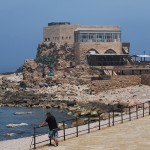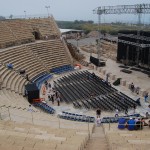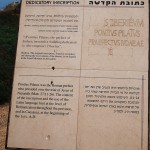Caesarea National Park
The ancient city of Caesarea is located in Israel, on the coast of the Mediterranean sea, between the isthmuses of the Crocodile Creek and the Hadera River.
Before the city of Caesarea was built, there was an old Phoenician settlement and port harbour called Straton’s Tower (Pyrgos Stratonos).
The first mention of the port harbour on the site of the present Caesarea is found in Zenon’s papyrus dated back to 259 BC, which was during the reign of the Persian Dynasty – after the destruction of the First Temple and almost all the way till the completion of the Second Temple in Jerusalem. At that time, Straton’s Tower harbour belonged to the area of an important port city – Dor. This area was captured by a Hasmonean king Alexander Janneaus, who annexed it to his kingdom of Judea in 103 BC; but less then forty years later, it was captured by Pompey and included into the Syrian Province.
In 31 BC, Roman Emperor Gaius Julius Caesar Octavius Augustus granted to King Herod the lands conquered by Pompey. On the site of Straton’s Tower, Herod rebuilt a city (the construction started in 22 BC), which he named after the Roman Emperor, who was his patron.
The city was built in record breaking, even for modern days, time – in twelve years. The city layout was of the Roman type – the main streets (Cardo and Decumanus) were built along north-south and west-east axes and intersected in Caesarea’s center. The exterior of many buildings in the city was decorated with marble and alabaster. There was a sewing system in the city, which was connected to the sea.
In keeping with its status of the emperor’s (Caesar’s) city, several temples, a theater, a racecourse, forums, saunas, aqueducts were erected in it; but the most impressive one was the construction of the port – one of the largest ones in the ancient world. Still in Herod’s lifetime, Caesarea became the stronghold of Rome and of Roman power in Judea. The temple that was devoted to the goddess of Rome – Roma, was called the temple of Roma and Augustus. It is believed that here the deification of the first and greatest of all Roman emperors – Augustus, began.
The population of Caesarea was predominantly pagan – Romans, Greeks, Syrians, but there was also a Jewish community there. It was in Caesarea where, sparkled by conflicts between these groups of society, Jewish revolt against Rome started, which became known in history as the Judean War. Here the spiritual leaders of the second revolt – Bar Kokhba revolt, were also executed. On a racecourse, which became the arena for gladiator fights by the beginning of the 2nd century, famous and revered rabbi Akiva was executed. And from this city of Caesarea prisoner Apostle Paul was sent to Rome.
During the period of Byzantine reign, the city was an important Christian center. On the foundation of the temple of Augustus and Roma, the Church of Saint Peter was erected; and such prominent Apologists of the Christian faith as Eusebius of Caesarea created their works in the city. At the same time, the huge port of Caesarea, which demanded constant restoration and maintenance works, no longer had its former state significance, and, little by little, the child of Herod the Great dilapidated.
During the epoch of Moslem conquests, the new culture of dry land trade did not give sea port cities any special significance, and Caesarea lost its political and economic status. Like many coastal cities, Caesarea remained in desolation until the 9th century, when the Arab world discovered for itself the world of sea trade.
Crusaders captured Caesarea during the First Crusade in 1109, and for almost two centuries Caesarea together with Jaffa, Arsuf, Kafarlab, Atlit and Akko was a crusader’s stronghold in the Holy land. The fortified walls of Caesarea of the crusaders’ times were erected by Saint Louis IX. From this site also the crusaders were leaving the Holy land carrying away with them riches and sacred relics. Who knows, maybe here the Holy Grail was forever lost. In 1265, the troops of great Mamluk conqueror Baybars put an end to the history of the city.
Only in the middle of the 19th century, when Turkish authorities allowed refugees from Bosnia to settle in the Holy land, they restored human presence in Caesarea on the ruins of the southern pier of the port of Herod the Great that survived till our days. Bosniaks left Caesarea during the Independence War and only during extensive archeological surveys of 1956-1964 and in 1992-1996, the greatness of the ancient city was again revealed to the world.
In our days, on the territory of the present city there is Caesarea National Reserve Park, in which extensive and active archeological excavations are still carried out to this day. Due to the change of the sea level, most of them are carried out under water. A Roman amphitheater has been excavated, which is still being used, city wall, racecourse, cobblestone square with gigantic statues, ruins of synagogues and churches, as well as numerous scrolls, in which first mentions about Pontius Pilate and Nazareth were found, including the Pilate Stone – a block with a tributary inscription of Pilate for Emperor Tiberius.
The most ancient of all discovered theaters on the territory of Israel has survived here, just like the ruins of the magnificent “Palace on a Reef,” the amphitheater of King Herod (Iztadion), sections of the city streets from Roman and Byzantine periods, public sauna facilities complex of Byzantine period with astonishing decorations, big artificial port of Hellenistic period and fortified city-port of Arab period, ruins of a temple complex, which combined constructions of Roman, Byzantine and Arab periods and of the Crusaders’ epoch. Of some interest also are the Square of Statues of Roman period, ruins of a synagogue of Byzantine period, remains of the Roman fortress wall, racecourse (2nd century AD) and fragments of aqueducts.





